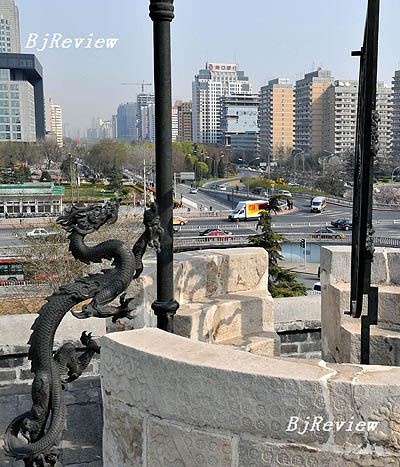|

Few visitors to Beijing would think the area around Beijing Railway Station a nice place to linger after seeing the station flooded with crowds of passengers. Yet a brick building nearby, one of world's oldest observatories, is well worth a tour.
With its well-preserved architecture and equipment the Ancient Observatory is known internationally and has been visited by heads of state, government officials and renowned scientists and astronomers from around the world.
The observatory was designed in the Yuan Dynasty (1271-1368) out of a turret in a gate of the city wall. The original construction was destroyed at the beginning of the Ming Dynasty (1368-1644) when the city was conquered and the surviving astronomical equipment was transported to Nanjing, an eastern Chinese city.
Today's structure was rebuilt on the site in 1442, using the original plans. It became the royal observatory and for the five centuries until 1929, astronomical observation was conducted there, making it one of the longest serving observatories in the world.
Renowned scientists of the Ming Dynasty created a lot of original observation equipment that is still in the observatory today. Xu Guangqi was one of those astronomers. He worked as a teacher in the daytime and studied technology related to agricultural production in the evening. As agricultural production was closely related to astronomy and irrigation, which depend on mathematics, Xu read many books on all three subjects.
In around 1595, Xu met a Catholic missionary named Lauzaro Catneo, who introduced him to Western science. Xu was told that Italian Jesuit missionary Matteo Ricci possessed authoritative scientific knowledge, so he paid a visit to Ricci and became his student.
During the Qing Dynasty (1644-1911), the Ancient Observatory adopted Western technology to produce eight pieces of copper observation equipment. These large pieces of equipment are elegant in shape, showcasing the cultural exchanges between East and West. The carved patterns and molding of the equipment are Chinese while the scales and the internal structure are imported from Europe. The equipment is still exhibited in the Ancient Observatory today.
The production of one of the eight pieces of copper equipment was presided over by Liu Songling, the Chinese name of Slovenian Augustin F. Hallerstein. He was trusted by the Chinese emperor and appointed as the head of the royal observatory for 28 years.
In 1900, when the allied army of eight Western nations invaded Beijing, soldiers ransacked the Ancient Observatory and stole much of the observation equipment, which was eventually returned to China due to pressure. | 